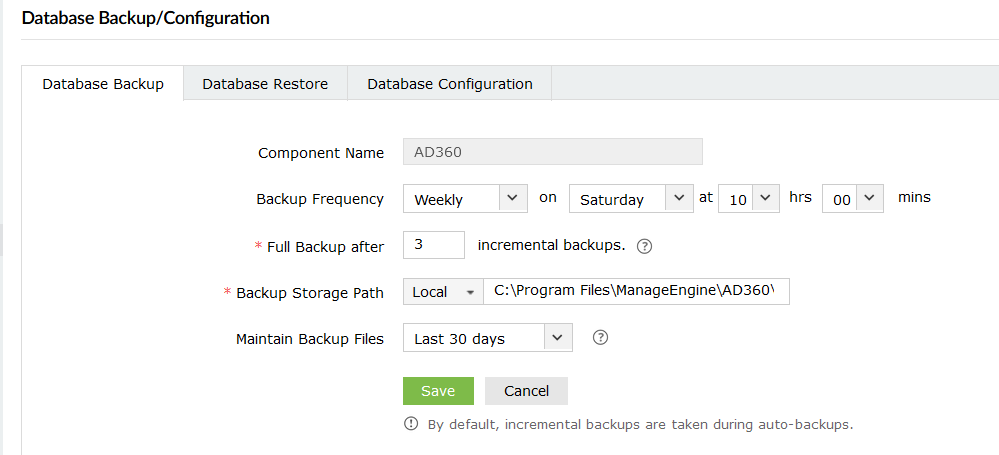Automatic database backup
AD360 can automatically back up its database and the databases used in the integrated products at regular intervals, as scheduled by you. Using this option, you can back up the built-in PostgreSQL DB or external PostgreSQL and MS SQL databases configured in the product.
Supported DB versions for auto backup
- PostgreSQL: 9.6 to 10.21
- MS SQL: 2008 and above
Prerequisite for backing up external PostgreSQL
- In the machine where PostgreSQL is installed, go to <postgresql_installdir>/data and open the posgresql.conf file. Search for wal_level entry. Uncomment the entry and change its value to archive.
- Copy all the files in <postgresql_installdir>/lib and <postgresql_installdir>/bin folders and paste them in <product_home>/pgsql/lib and <product_home>/pgsql/bin folders respectively. <product_home> refers to the home directory of AD360 or the integrated products for which you're configuring the auto backup scheduler.
- Restart the external PostgreSQL server.
- Repeat the steps 1 to 3 from above whenever you update the PostgreSQL server.
Steps to schedule database backup
- Navigate to Admin → General Settings → Database Settings → Database Backup.
- Choose AD360 or an integrated product for which you want to schedule auto backup, and click the edit
 icon.
icon.

- Select whether you want to schedule the backup daily, weekly, or monthly and at what time from the Backup Frequency drop-down.
- Enter the number of incremental backups to take for every full backup in the Full Backup after __ incremental backups box. Enter 0 if you want to take only full backups.
- Enter the Backup Storage Path.
- You can either choose a local folder or shared folder to store the backups.
- If the shared folder you’ve chosen needs permission to store the backups, then put a check against the Authentication Required box, and enter the necessary credentials.
Note 1: If the shared folder is located in a workgroup computer, then create a new domain account in AD. This new account should have the same username and password as that of a local account in the workgroup computer. Use the credentials of this new account for authentication.
Note 2: If the specified path is wrong or unreachable, the backup will be stored in the default backup folder (<Installation_Folder\Backup>).
- Set a retention period for the backup files from the Maintain Backup Files drop-down.
Note: If you use MS SQL, two backup files are created every time a backup operation is run. An .ezip file is created in the <AD360_Installation_Folder>\backup and a .bak file is created in the <MS SQL_directory>\backup. Both backup files are required to carry out any restoration. When you configure a retention period, only the .ezip file in <AD360_Installation_Folder>\backup will be deleted. The .bak files in the <MS SQL_directory>\backup will not be deleted. To delete the .bak files, set up a maintenance plan in Microsoft SQL Server management studio based on your retention period.

- Click Save.
Other settings
- To disable auto backup for AD360 or a particular integrated product, click the
 icon located in the Actions column of the auto backup configuration table.
icon located in the Actions column of the auto backup configuration table.
- To get the status of the latest backup, click the
 icon.
icon.
- To edit the backup schedule for a particular component, click on the
 icon located in the action column of the component.
icon located in the action column of the component.
- Use the Backup Now option to initiate a backup instantly.
- Use the Recent Backups icon in the status column to view all available backups.
Restoring backup from an old version of MS SQL server to new MS SQL server
If you've installed a new version of MS SQL server and want to configure it in AD360 or its integrated products in place of the old MS SQL server, you can do so by using the backup you've taken using AD360. Just note that, in addition to the backup you've taken using AD360, you need to copy the files in <MS_SQL_Old_Version>/Backup to <MS_SQL_New_Version>/backup.
Troubleshooting tips
If you get an error while backing up the database, please check whether:
- The database server is running.
- There is sufficient space in the backup storage location.
Don't see what you're looking for?
-
Visit our community
Post your questions in the forum.
-
Request additional resources
Send us your requirements.
-
Need implementation assistance?
Try onboarding


 icon located in the Actions column of the auto backup configuration table.
icon located in the Actions column of the auto backup configuration table. icon.
icon.